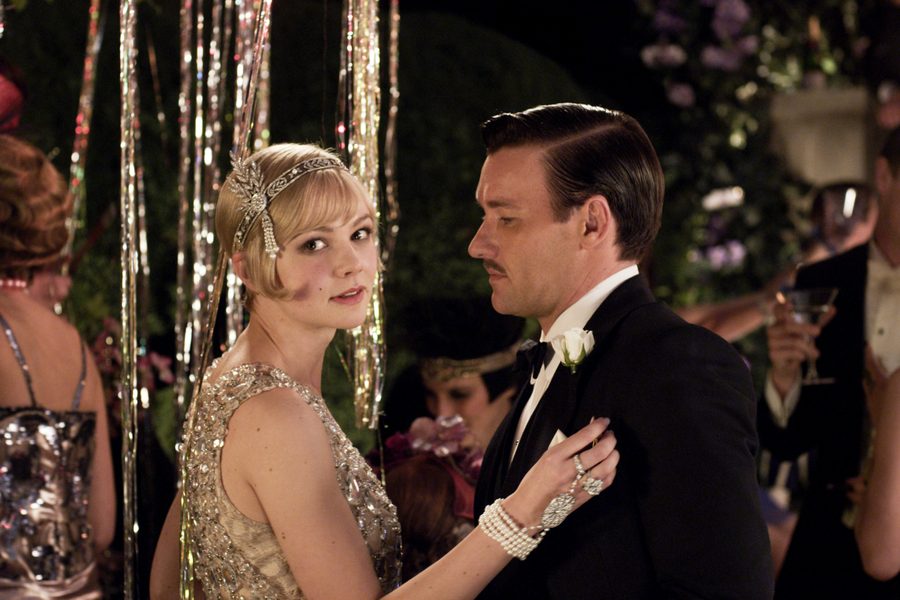Bring on the Trash
Baz Luhrmann’s Great Gatsby gets the tackiness right, but the flappers wrong.
Jude Ellison Sady Doyle

When word broke in 2008 that the latest cinematic version of The Great Gatsby would be directed by Baz Luhrmann — the guy who gave us Mercutio as an Ecstasy-slinging drag act in Romeo + Juliet and whose career retrospective will probably be titled SEQUINS! The Motion Picture Experience—there was much wailing in the streets. And when word broke out that the new, be-sequined Gatsby would be presented in 3-D, that wailing turned into the rending of flesh. What, faithful readers demanded to know, what could a vulgarian like Luhrmann — that impresario of gaudy, full-bore, bad-taste excess — possibly know about The Great Gatsby?
Well, for one thing, Gatsby is a novel about an impresario of gaudy, full-bore, bad-taste excess. And so, unlike the (mostly unimpressed) reviewers who seemed to never get past their shock that Luhrmann had the nerve to make the film at all, I found the film’s take on Jay Gatsby to be an inspired one. Only a director capable of genuine vulgarity could present the character in all his original, pre-canonized glory. Fitzgerald’s novel has been largely killed by our respect for it: We’re so entranced by the knife-sharp social distinctions and glittering descriptions of parties that we miss the fact that the parties themselves were stuffed with weirdos, proscribed substances, vomit and pop music you could hump your partner to, as offensive to genuinely sophisticated tastes as … well, as The Great Gatsby in 3-D. Jay Gatsby has been cited as an inspiration for the dashing, astute Don Draper, but with his joyous vulgarity, his tasteless emulation of the “celebrated people” he crams into his mansion and his endless pursuit of swag, the contemporary character Gatsby actually most closely resembles is Parks and Recreation’s Tom Haverford. Leonardo DiCaprio seems to get the essential comedy of Gatsby, playing him as a teenager who’s been assigned the role of “super-cool rich guy” in a school play — earnest, stilted, over-the-top, and completely incapable of saying the phrase “old sport” without seeming like both an insecure weirdo and a lovable little boy.
The Great Gatsby has never been about elegance. It’s about the emptiness of elegance, and about a point in history when the gilded fortress of money and tradition and power cracked, and the teeming hordes began to pour through. It’s about the summer when a man with a bright pink suit and a bright yellow car and a ridiculously garish Rent-A-Mansion became one of the most important people in New York. It’s about a decade in which new money and people of color and women began to become dangerously visible and self-determined — determining the look and sound of youth culture, forming literary movements in Harlem, and, in the case of women, voting.
But getting the excess and glitter of Gatsby right is only the first part of the problem. It’s also the easiest one; all you have to do is sprinkle on a lot of glitter, something which Baz “Could We Do It With Fireworks?” Luhrmann may actually list as a skill on his current resume. What’s harder is staying true to Fitzgerald’s weird clairvoyance — the way he managed to nail the tense undercurrents of race and class and gender inherent in the decade’s culture, while actually being on the wrong side of every single issue. And this is something that Luhrmann, who’s even less conscious of these issues than F. Scott, mostly fails.
Fitzgerald’s treatment of people of color, and non-WASPs in general, is muddled and pathetic — we’re supposed to hate the old-money brute Tom Buchanan for fulminating about “colored empires,” but we’re also supposed to join in on the anti-Semitic joke that is the character of Gatsby’s boss. All while excessively white people who have probably never learned a black person’s name in their lives celebrate the “Jazz Age.”
The female characters of the novel, meanwhile, are a record of Fitzgerald’s ambivalence toward the “new woman” of the 1920s. The women in Gatsby—the icy, athletic Jordan; the gorgeous, sparkling, self-involved Daisy — are indelibly charismatic and appealing characters, and they’re both essentially villains. Jordan is a famous athlete who cheats to win, and Daisy kills a woman and lets the man who loves her take the fall.But while The Great Gatsby may be confused about the sudden influx of people of color and women, it is dead-on about how the people in power reacted, which is to say: They panicked.
It’s a shame that Luhrmann’s so intermittently perceptive on these issues, because when he’s on point, he actually outdoes Fitzgerald. He confronts the problem of the novel’s thundering whiteness by having people of color always there, always visible on the screen, having their own parties and conversations; they’re also frequently audible on the soundtrack. (In a touch of something like genius, the soundtrack to Luhrmann’s Gatsby was executive-produced by Jay-Z.) The way the white characters maneuver blithely around them, as if behind some portable soundproof glass that prevents them from engaging, is strikingly — and, I think, intentionally — uncomfortable. The only person of color that anyone does talk to is Gatsby’s Jewish boss, played this time around by veteran Indian actor Amitabh Bachchan. Making Meyer Wolfsheim the only person of color in the movie with a speaking part restores the full ugliness of the characters’ instinctive loathing of him—his funny accent! his vulgarity! his Otherness!—and Bachchan’s restrained, menacing portrayal does the rest of the work, portraying Wolfsheim as a dangerous man in a society that has given him no opportunity to advance through more genteel means. The film also makes clear that people don’t just distrust and dislike Gatsby because of his weird linguistic affectations and tacky suits; they distrust him because his job involves talking to, and respecting, non-white people. One of the many things Gatsby does to worry Nick Carraway, in this version of the story, is walk up to a black man and shake his hand.
But because Luhrmann’s treatment of race is startlingly smart, it’s all the more frustrating when he stumbles over class and gender. Class is knocked out of the picture in the opening voice-over: Whereas the novel’s Nick Carraway was told, growing up, to “remember that all the people in this world haven’t had the advantages that you’ve had,” the film’s Nick Carraway is told to “try to see the best in people.” Which is a very different task, and a completely apolitical one to boot. Gatsby’s indelible line about the appeal of Daisy Buchanan, “her voice is full of money,” is similarly cut. Omissions like this are what keeps Luhrmann’s Gatsby from ever gaining the traction it ought to have.
Which brings me to the tragedy of what Luhrmann has done with Jordan and Daisy, two of literature’s most compelling exemplars of emerging 20th-century femininity — smart and witty and complicated and alarmingly autonomous; driven, to the male characters’ frustration, by agendas that have little or nothing to do with men and which they never condescend to explain. Baz Luhrmann, flappers were not spangly femme glamourpusses in funny hats: They were loud, proud, frightening gender deviants — cutting their hair off, binding their breasts, smoking and drinking in public, and having the kind of sex (premarital and frequent) that women are still shamed for having today. The Daisy and Jordan of the novel are hard, cruel, reckless women whose very recklessness had something heroic about it. If they have to be women born in this particular part of the 20th century, by God, they’ll make the 20th century pay.
In Luhrmann’s world, they’re mush, existing largely to wear Prada gowns and be mooned at by men. Daisy, in particular, is more or less reduced to The Girl In The Picture: She swans around, fluttery-voiced and teary-eyed, with none of the chilly opacity and remove that make her a sinister figure in the novel. And poor Jordan is simply not there at all. She’s a clotheshorse who pops up at odd moments to deliver exposition in a newer and sillier hat. Her entire personality and back story have been torn out to make room for more sequins.
To hell with a tasteful Gatsby, I say. Give us trash. Give us the shock of the real thing: a bunch of self-involved wealthy white people arguing about who’s the richest and whitest while they all listen to Jay-Z. But for the love of God, make it clear what’s causing all the noise. Fitzgerald, though he lacked the smarts to understand his novel’s political subtext in full, had the talent to deliver it nonetheless; his book outlined the flaws of 1920s boom mentality before anyone, even he, had reason to understand the flaws would be fatal. Show us what’s making Tom Buchanan so paranoid — the revolution that’s providing the soundtrack to his parties and sleeping with his wife, represented in no small part by the wife herself.
There’s one moment in Luhrmann’s Gatsby that I honestly loved: The moment when the doomed Myrtle’s trashy girlfriends burst into a room, loud and cackling and with broader-than-broad working-class Queens accents, high on nerve pills and sloshing illegal booze. They look very recognizably like flappers. And at the moment they show up, the soundtrack bursts into stereophonic sleaze, and everything goes straight to pill-popping hallucinogenic Party Hell. As far as feminist victories go, it’s not a big one. But the shock and horror of those girls and those sounds entering Nick’s fragile world is a five-minute lesson on what the 20th century must have felt like to the lofty and elegant white men watching everyone else claw their way up.
Jude Ellison Sady Doyle is an In These Times contributing writer. They are the author of Trainwreck: The Women We Love to Hate, Mock, and Fear… and Why (Melville House, 2016) and was the founder of the blog Tiger Beatdown. You can follow them on Twitter at @sadydoyle.








